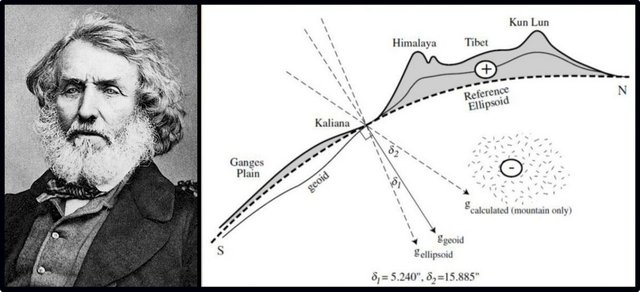
The fifth and final section of Chapter 8 of Immanuel Velikovsky’s Earth in Upheaval is called The Rotating Crust. In this section Velikovsky finally identifies what he believes was the principal cause of the Ice Age―but not its mechanism. In the first four sections he briefly discussed and rejected a number of other possible causes:
- Pole Shifts
- Continental Drift
- Changes in the Earth’s Orbit
- Changes in the Earth’s Obliquity
As the title of the chapter—Poles Displaced—serves to remind us, Velikovsky believed that during the Ice Age the Earth’s poles occupied positions different from the ones they occupy today. This, he believed, was required by the asymmetric arrangement of the glacial ice caps during the Pleistocene Ice Age.
The solution, if Velikovsky is on the right track, is that the Earth’s crust is not always locked to the underlying mantle but may, under exceptional circumstances, become detached, allowing it to slide en masse over the mantle. This is what Velikovsky refers to as the rotating crust.
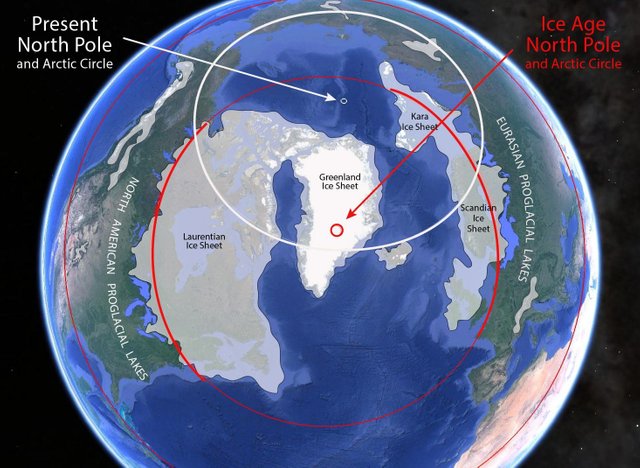
Isostasy
This section opens with a discussion of the principle of isostasy, or isostatic equilibrium. This is the state of gravitational equilibrium that exists between the crust and the mantle—or, to be geologically accurate, between the lithosphere and the asthenosphere. The lithosphere comprises the crust and the rigid, uppermost layer of the mantle, known as the lithospheric mantle. The asthenosphere comprises the plastic layer in the upper mantle that lies immediately beneath the lithosphere. The crust and mantle are distinguished by their composition, while the lithosphere and asthenosphere are distinguished by their mechanical properties.
The theory that the terrestrial crust is swimming on magma was first offered when J. H. Pratt, in the 1850s, found that the Himalayas, the largest massif on earth, do not exert the expected gravitational pull and do not deflect a plumbline. Astronomer G. B. Airy was surprised, to the point of disbelief in fact; but then he offered a theory that the granite crust, much lighter than the magma underneath, is only sixty miles thick, and that under the mountains, on the inside of the crust, there are reversed mountains, immersed in the heavier magma, which would account for the lack of gravitational pull by mountains. This is the theory of isostasy. (Velikovsky 113-114)
John Henry Pratt was a British clergyman, astronomer and mathematician. He joined the British East India Company in 1838 as a chaplain and it was while he was working in India that Andrew Scott Waugh, the Surveyor General of India, asked him to examine some anomalies that had been observed during the Great Trigonometrical Survey of the subcontinent. Plumblines were not behaving as predicted in the vicinity of the Himalayas.
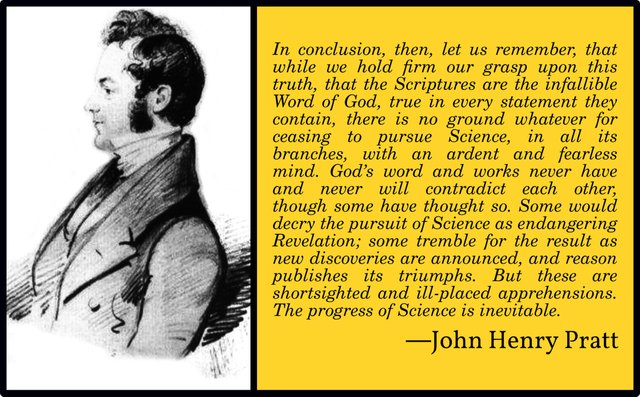
A similar anomaly had been observed in South America in the previous century by the French geodesist Pierre Bouguer. While attempting to determine the shape of the Earth, Bouguer discovered that his plumbline was not being deflected by the Andes as much as he had expected. This phenomenon is known today as the Bouguer Anomaly.
So while Pratt did not discover the anomaly himself―as Velikovsky seems to imply―he did communicate it to the scientific community in Britain in a very technical paper, which was read to the Royal Society in London in December 1854 by his colleague James Challis.
Between 1860 and 1865 Pratt published A Treatise on Attractions, Laplace’s Functions, and the Figure of the Earth, an extensive revision of Mathematical Principles of Mechanical Philosophy, which he had written almost a quarter of a century before. In the fourth edition of his Treatise Pratt offered the following solution of the plumbline problem:
In a previous edition we gave an argument in favour of a great thickness, arising from the tendency of the weight of the enormous mass of the Himalaya mountains to break down the crust if it is thin; and of the fluid mass below extensive ocean-beds to burst them up under the same circumstances. Subsequent calculations, however, on another subject have shown that the crust below the mountains must be of less density, and that below ocean-beds of greater density than the average, so as to produce a very considerable compensation. (Pratt 1871:136-137)
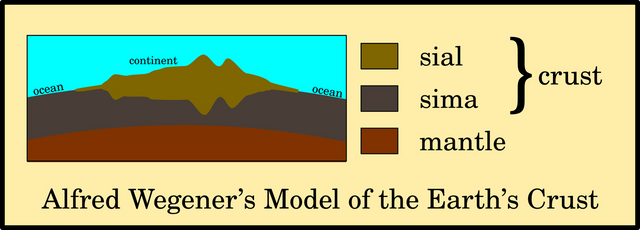
Pratt was probably the first to differentiate between continental crust and oceanic crust on the basis of their respective densities. The German geologist Alfred Wegener―inspired by geologist Eduard Suess and zoologist Georg Johann Pfeffer―later adopted the terms Sial and Sima for these layers, due to the preponderance in them of silica, alumina and magnesia.
Another of Pratt’s hypotheses, however, has not fared so well: the theory that mountain ranges and oceanic basins were all created around the same time, when the Earth cooled and solidified:
An hypothesis which the foregoing calculations seem to point to is this, That, supposing that the earth was once in a fluid state, as it became solid it contracted unequally, leaving mountains where it contracted least and ocean-beds where it contracted most. (Pratt 1871:201)
In Pratt’s model of isostatic compensation the rigid crust is floating on a relatively fluid mantle of denser material. The base of the crust lies at a uniform depth―the depth of compensation. Above this level, the weight per unit area of the crust is constant. This requires that the least dense parts of the crust (mountains, according to Pratt) be thicker than the densest parts (oceans), so that the overall mass of any section of crust remain constant and sink into the mantle by the same amount as every other section of the crust of the same cross-sectional area:
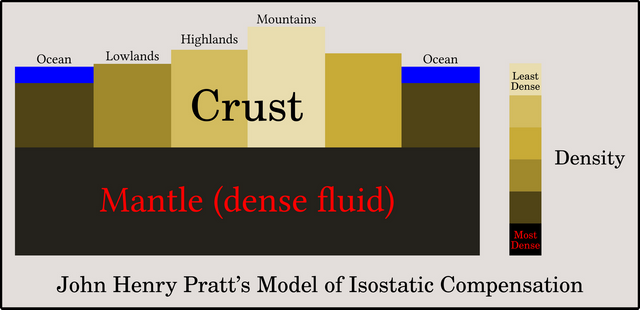
George Biddell Airy
Published in the same volume of the Philosophical Transactions is the Astronomer Royal George Biddell Airy’s initial reply to Pratt’s paper. Airy opens his paper by expressing considerable surprise at Pratt’s observations—though Velikovsky is exaggerating when he says that Airy was surprised to the point of disbelief:
A paper of great ability has lately been communicated to the Royal Society by Archdeacon Pratt, in which the disturbing effects of the mass of high land north-east of the valley of the Ganges, upon the apparent astronomical latitudes of the principal stations of the Indian Arc of Meridian, are investigated. It is not my intention here to comment upon the mathematical methods used by the author of that paper, or upon the physical measures on which the numerical calculation of his formulae is based, but only to call attention to the principal result; namely, that the attraction of the mountain-ground, thus computed on the theory of gravitation, is considerably greater than is necessary to explain the anomalies observed. This singular conclusion, I confess, at first surprised me very much.
Yet, upon considering the theory of the earth’s figure as affected by disturbing causes, with the aid of the best physical hypothesis (imperfect as it must be) which I am able to apply to it, it appears to me, not only that there is nothing surprising in Archdeacon Pratt’s conclusion, but that it ought to have been anticipated; and that, instead of expecting a positive effect of attraction of a large mountain mass upon a station at a considerable distance from it, we ought to be prepared to expect no effect whatever, or in some cases even a small negative effect. (Airy 101)
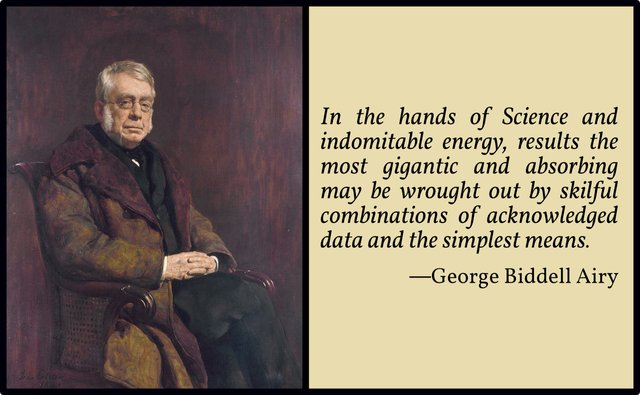
According to Airy’s Theory of Isostatic Equilibrium, the base of the crust does not lie at a uniform depth but varies from place to place depending on the thickness of the crust. The continental crust is assumed to be of roughly uniform density, unlike Pratt’s model which hypothesizes that mountains are less dense than lowlands. Thick sections of crust, therefore, weigh more than thin sections, and so ought to sink deeper into the mantle. To explain why mountains remain at high elevations above sea level, Airy hypothesized that beneath mountains there are deep mountain roots, somewhat analogous to the submerged part of an iceberg. The continents float in the fluid mantle like icebergs floating in the ocean.
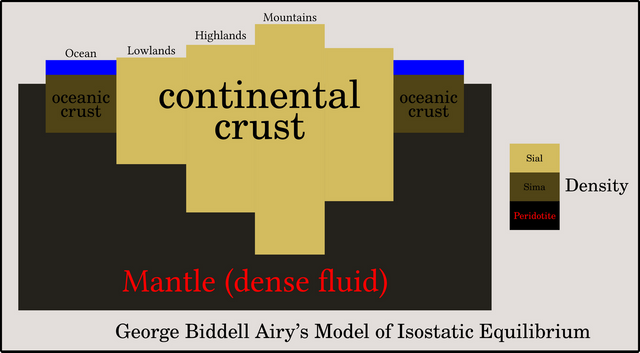
Pratt’s Theory of Isostatic Compensation and Airy’s Theory of Isostatic Equilibrium are two different ways of modelling isostasy. Both have been adopted and modified by geologists over the past century and a half. There are also a handful of rival models:
Pratt
Airy
Hayford & Bowie a refinement of Pratt’s model
Heiskanen mainly a refinement of Airy’s model, but with some features taken from Pratt
Joly a compromise model that shares certain features with both the Pratt and the Airy models
Vening Meinesz the Flexural Isostasy model, which hypothesizes regional rather than local compensation due to the rigidity of the crust
Holmes a refinement of Airy’s model
There is still no scholarly consensus on which of these models is to be preferred, though Heiskanen’s seems to attract more support today than any of the others. The existence of Airy’s deep mountain roots was confirmed by seismic studies in the 1970s.
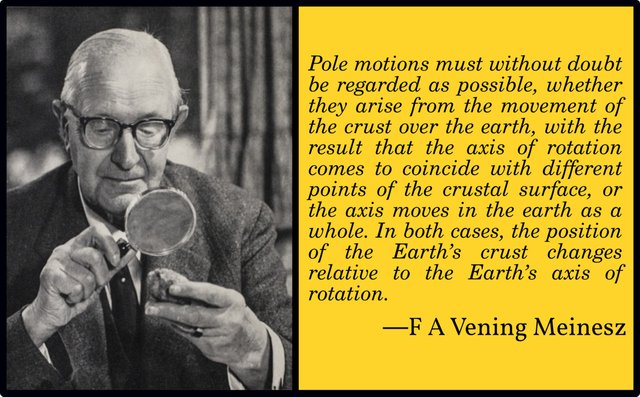
Vening Meinesz
Velikovsky next turns to the isostatic model developed in the first half of the 20th century by the Dutch geophysicist Felix Andries Vening Meinesz. In the 1920s Vening Meinesz discovered gravity anomalies on the ocean floor―discrepancies between the observed gravity and that predicted by theoretical models―using a special pendulum of his own invention, which he deployed from a submarine provided by the Dutch Navy. This discovery led him to develop his own isostatic model, known variously as Flexural Isostasy, Lithospheric Flexure, and Regional Isostasy.
Vening Meinesz was one of the first geophysicist to distinguish between the crust and the lithosphere. He was happy to concede that Airy’s isostatic model was accurate as far as the crust was concerned, but a more sophisticated model was required to properly describe the isostasy of the lithosphere, which included both the crust and the uppermost layer of the mantle. In this model the lithosphere is rigid but elastic: under stress it flexes and bends on a regional scale, rather than buckling and breaking on a local scale.
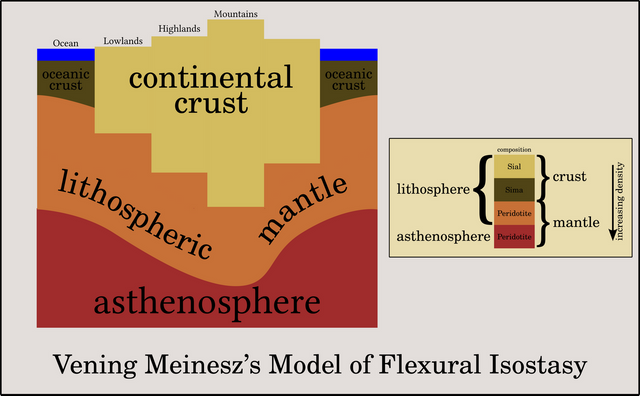
Velikovsky quotes from Vening Meinesz’s paper Spanningen in de aardkorst tengevolge van poolverschuivingen [Stresses in the Earth’s Crust due to Pole Shifts]. He misspells aardkorst as aardrost―a misspelling that has been repeated by many Velikovskians. Two papers on this subject were published by Vening Meinesz in 1943, the first in the Proceedings of the Royal Netherlands Academy of Sciences and the second in the Journal of the Royal Dutch Geographical Society. Their titles are almost identical:
Felix Andries Vening Meinesz, Spanningen in de aardrost tengevolge van poolverschuivingen, Proceedings of the Royal Netherlands Academy of Sciences, Volume 52, Number 5, Royal Netherlands Academy of Arts and Sciences, Amsterdam (1943)
Felix Andries Vening Meinesz, Spanningen in de aardkorst door poolverschuivingen, Journal of the Royal Dutch Geographical Society, Volume 60, Number 4, Pages 530-535, Royal Dutch Geographical Society, Amsterdam (1943)
Both titles translate as Stresses in the Earth’s Crust due to Pole Shifts.
These papers are in Dutch. I don’t know if Velikovsky knew Dutch or had the earlier paper translated for him by someone who did. I have not been able to find an English translation of either paper online, though the original Dutch of the second paper is freely available. I translated it for my own research using ImTranslator.
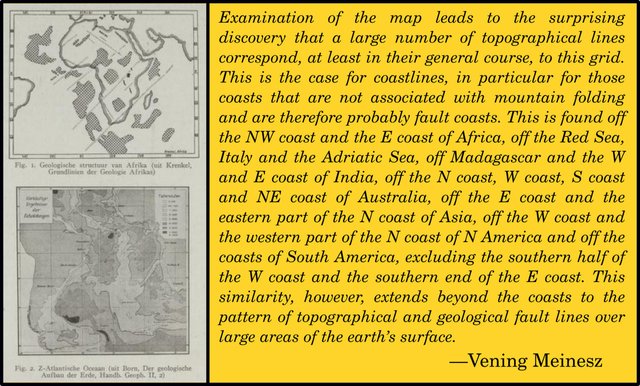
To the study of isostasy and its anomalies (gravitation is, strangely, stronger over deep seas), F. A. Vening Meinesz, Dutch geophysicist and explorer of oceans, made many important contributions. He found in the very structure of the terrestrial crust signs of some violent displacements on a global scale. Thus it is not merely in order to explain the climates of the past that the dislocation of the crust is postulated. In 1943, Vening Meinesz analyzed “the stresses brought about by a change in position of the rigid Earth’s crust with regard to the axis of rotation of the Earth.” In this analysis he surmised the crust “to have the same thickness everywhere and to behave as an elastic body.” He pointed out that if we assume that the crust happened to move clockwise in relation to the core by over 70° the expected effect “shows a remarkable correlation to many major topographic features and also to the shearing patterns of large parts of the Earth’s surface, as, e.g., the North and South Atlantic, the Indian Ocean and the Gulf of Aden, Africa, the Pacific, etc. If the correlation is not fortuitous, and this does not appear probable, we have to suppose that the Earth’s crust at some moment of its history has indeed shifted with regard to the Earth’s poles and that the crust has undergone a corresponding block-shearing.” (Velikovsky 114)
The assumption that the crust (more accurately, the lithosphere) has the same thickness everywhere is only made tentatively for the sake of argument. Vening Meinesz concedes that we cannot be sure about this. Nor do we know whether the boundary between the lithosphere and the asthenosphere is sharp or gradual, or even how thick the lithosphere is.
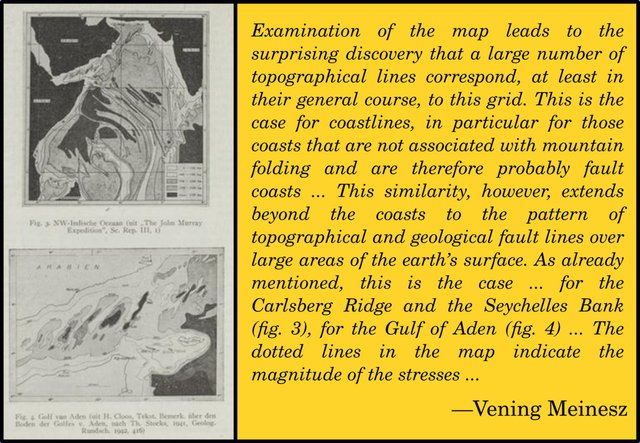
Unfortunately for Velikovsky’s thesis, Vening Meinesz dates this pole shift to a remote period in the Earth’s history:
The large number of similarities makes it unlikely that we are dealing with chance here, although it is still too early to pass a final judgment on this. Assuming that this coincidence can be ruled out, one would conclude that a pole shift must have occurred at some time, and that it led to the fracture of the earth’s crust, thus giving rise to many lines of the present-day topography. This probably must have happened early in the crust’s history, as several lineages are almost certainly ancient ...
Since the polar movement that led to the rupture of the crust, the pole may have moved further; after all, it is unlikely that this would have led to shear phenomena again after the crust had already been split into blocks. We cannot, therefore, say anything about the occurrence of polar motions in those later geological periods, so that the hypothesis here advanced neither sheds light on nor conflicts with assumptions about such motions made on the basis of geological and palaeoclimatic data. In his book The Pulse of the Earth, Umbgrove, in response to these data, explains that, in his opinion, no significant polar motions have taken place, at least since the Palaeozoic. In this context, then, it would be simplest to suppose that the pole moved at a very early geological period from a place near Calcutta approximately to its present position, and that it has remained almost in place ever since. (Vening Meinesz 533 ... 535)
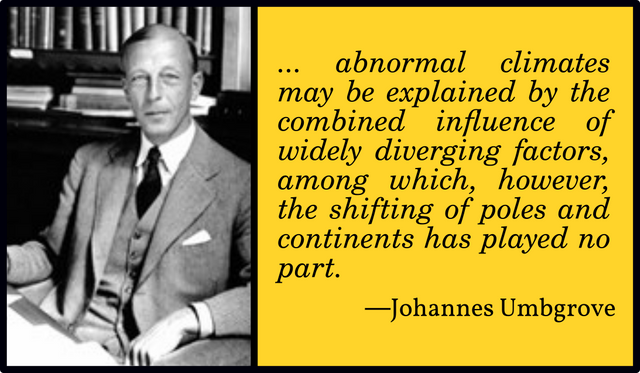
Johannes Herman Frederik Umbgrove was another Dutch geophysicist. Although he did rule out recent pole-shifts, he still left the door open for a rotating crust of the sort Velikovsky envisages:
Astronomical data do not support the view that the position of the earth’s rotation-axis has undergone any significant change, nor does the astronomer find it possible to suggest a cause for such a hypothetical occurrence. Moreover, the comparative rapid genesis of glaciation would require equally rapid hypothetical changes, but since the earth is a gyroscope, and thus has a powerful tendency to keep the axis of its rotation constant, any sudden alteration in its direction would only bring about a world-wide catastrophe. Historical geological data prove that nothing of the kind has ever happened.
On the other hand, it might be assumed that the position of the earth’s crust has undergone some changes in respect to the core. This would result in a different distribution of the continents in respect to the axis of rotation, and the latter’s position would then undergo a slight alteration owing to this process. It was this type of “shifting of poles” that was used by Köppen and Wegener when constructing their paleogeographic maps. Milankovitch published a mathematical treatise on this subject, showing that the North Pole lay in the vicinity of the Hawaiian Islands in the Paleozoic, and that since then it had migrated to its present position via Alaska. (Umbgrove 137)
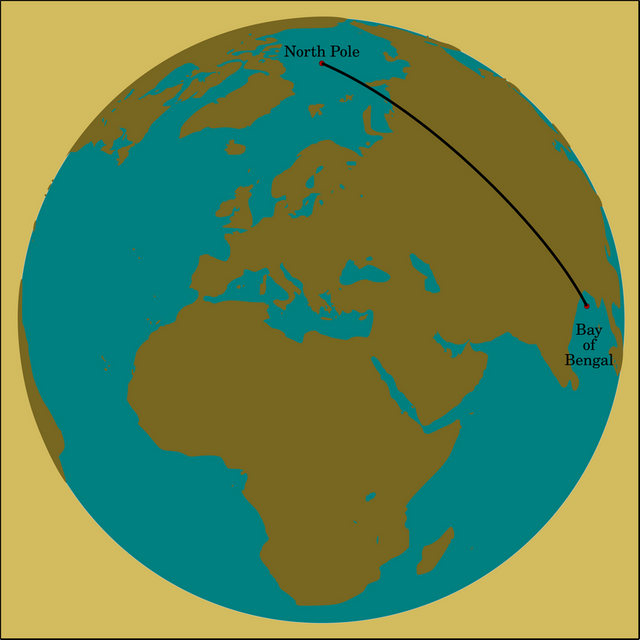
For a mainstream geophysicist Vening Meinesz is certainly not afraid to indulge in what most gradualists would regard as wild speculations. In his paper he envisages a pole shift of no less than 70°, from a latitude of 20° N and a longitude of 90° E―ie a point in the Bay of Bengal―to its present position. But he dates this shift to some time in the early geological history of the planet, and cites his colleague Umbgrove to the effect that there have been no significant pole shifts in the last 250 million years. Although this is not quite what Velikovsky wants to hear, it only applies to pole shifts brought about by a change in the position of the Earth’s axis of rotation. Velikovsky’s hypothesis is that recent pole shifts occurred when the lithosphere slid over the asthenosphere.
Velikovsky concludes his discussion of isostasy by casting some doubts on the very principle itself:
However, according to the theory of isostasy, the crust is not of the same thickness everywhere, the crustal protuberances are immersed in a very thick and viscous magma, and for the crust to move, even if it is only sixty miles thick, would require a greater force than is available under prevailing conditions in the solar system or on the earth itself.
The very idea of a crust changing its position in relation to the axis of the interior, or of the globe itself, presupposes the validity of the theory of isostasy. This theory, though generally accepted, finds difficulty in explaining the propagation of seismic waves around the globe. If the earth’s crust is not just sixty miles [100 km] thick―which, in relation to the volume of the magma, is as the thickness of the shell to the content of an egg―but two thousand miles [3200 km], as some scientists assume, then, of course, the displacement of the crust requires forces nearly as powerful as would the displacement of the entire globe, by inclining its axis into a new position in respect to the cardinal points of the sky. (Velikovsky 114-115)
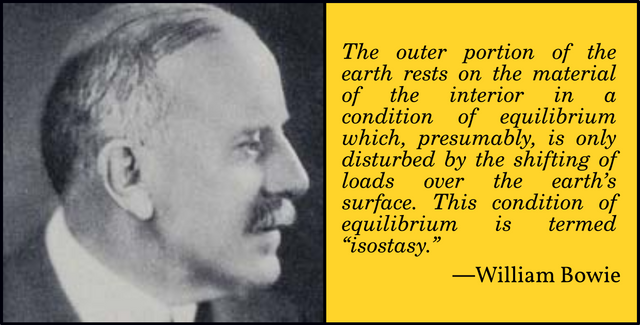
His source for these doubts is the American geodetic engineer William Bowie, who wrote the chapter on isostasy in Volume 2 of a series of textbooks on the physics of the Earth published by the National Research Council in the 1920s and ’30s. Bowie, however, did not actually doubt the reality of isostasy:
The data secured from observations for the variation of latitude, earth and ocean tides, and the transmission of seismic waves indicate that the earth is either solid throughout with the rigidity of steel, or that it is solid to a distance approximately 2,000 miles below sea-level, with the solid portion having a rigidity greater than that of steel. This seems to indicate a contradiction between isostasy and geophysical data. This, however, cannot be, for isostasy certainly exists, and, besides, there are many substances which are solid and resist deformation when stresses less than the elastic limit are applied for a short time but which will yield without fracturing when stresses much smaller than the elastic limit are applied for long periods of time.
Since the earth’s crust is in isostatic equilibrium to a very marked degree, it is reasonable to assume that this condition has obtained in the past and that it will continue in the geological future. The proof of isostasy furnishes evidence regarding at least the outer portion of the earth which should be of value to the geophysicist and to the geologist in their studies of the physical properties of the earth and in the effort to interpret geological history. (Bowie 104-105)
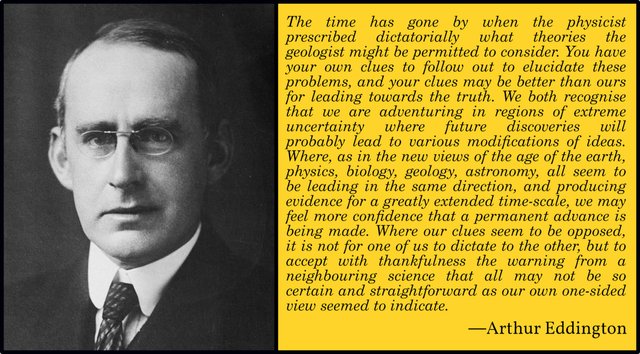
Isostasy and the Ice Age
Velikovsky now returns to the question of the Ice Age and its cause. He opens the discussion with a quotation from an article in The Scientific Monthly by Karl A Pauly, an electrical engineer from the Massachusetts Institute of Technology. In this article entitled The Cause of the Great Ice Ages Pauly analyses from an engineering point of view a theory recently proposed by the British astrophysicist Arthur Eddington:
In a paper entitled “The Borderland of Geology and Astronomy,” A. S. Eddington suggested that the Great Ice Ages were caused by shifting of the earth’s outer crust, over the interior, as a result of tidal friction. Under the influence of tidal friction alone the lithosphere would drift in an east-west direction, but Eddington also suggested that its course might be altered by excessive local friction between it and the substratum caused by buckling of the lithosphere. Because of my intense interest in the subject, I undertook to determine whether Eddington’s hypothesis might be correct. (Pauly 89)
The Borderland of Astronomy and Geology was a short lecture which Eddington delivered before the Geological Society of London on 21 November 1922. When it was subsequently published in the journal Nature, it ran to only four pages. The lecture is mainly about the origin and age of the Solar System―an astronomer throwing out ideas to his colleagues in the field of geology. It is when he discusses the origin of the Earth-Moon system that Eddington formulates his theory of crustal rotation:

The main features are that the moon at one time formed part of the earth, and broke away. At that time the rotation period of the earth was between 3 and 4 hours, and the cause of the fracture was that the solar tidal force synchronised with a free period of natural vibration of the earth; owing to resonance the tidal deformation of the earth continually increased until rupture occurred. The earth’s period of rotation has since lengthened to 24 hours, owing to frictional dissipation of energy by lunar and solar tides; and the back-reaction of the lunar tides on the moon has caused the moon to recede to its present considerable distance ...
The frictional dissipation acts as a brake on the earth’s rotation, and we now feel confident that the brake is a surface-brake applied at certain points on the earth’s surface where the favourable conditions exist. The retarding force is transmitted to the earth’s interior, and so delays the rotation as a whole; but unless the material is entirely non-plastic there will be a tendency for the outer layers to slip on the inner layers. I do not know how much the material a few hundred miles below the surface would be expected to give under the strain; it may be inappreciable, but I will assume that though small it has some effect.
We have then the whole crust slipping from east to west over the main part of the interior. Probably it would go very stickily, sometimes arrested by a jamming which would hinder it for a time and then going on more easily. (Eddington 20)
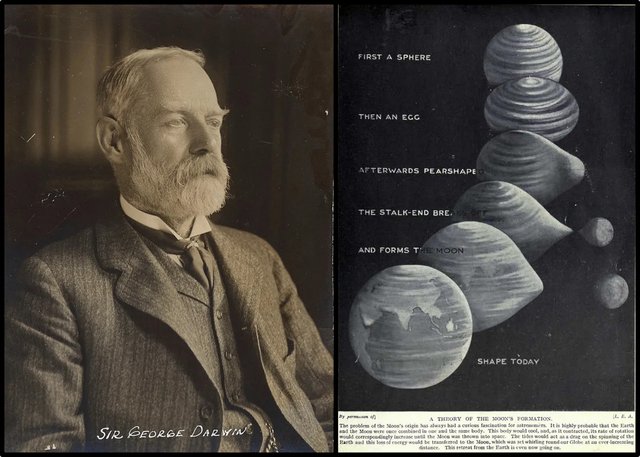
If I understand him, Eddington envisages a continuous and very slow sliding of the crust over the mantle due to lunar tidal forces. This is not the catastrophic jolting of the crust that Velikovsky requires, though Eddington’s stickily leaves the door open for some jolting. But it is not something that happened catastrophically in the past. It is something that is taking place today―analogous to orogeny, continental drift, or the gradual slowing of the Earth’s rotation. Nevertheless, Eddington does briefly discuss the possibility that a sliding crust could be the cause of ice ages:
I have regarded the crust as fairly mobile from east to west. I suppose the geologists would also like it mobile from north to south in order to have glacial periods in those portions which are now near the equator. It is not possible to hold out much encouragement for such an idea, because we cannot imagine any force acting from north to south. Still, if the crust, which is being urged by the east-west force of tidal friction, is resisted by obstacles it may be deflected, finding that, say, a south-west track offers less resistance. In a long enough time almost any displacement may have happened, granting my hypothesis that the connexion of the crust to the interior is reasonably plastic. So I cannot forbid this possible interpretation of glacial periods in the earlier geological times. (Eddington 21)
When Eddington refers to glacial periods in earlier geological times he seems to be excluding the recent Ice Age. He is referring to evidence of glaciation in equatorial lands―something which is usually explained today by invoking continental drift. These ice ages took place tens or hundreds of millions of years ago.
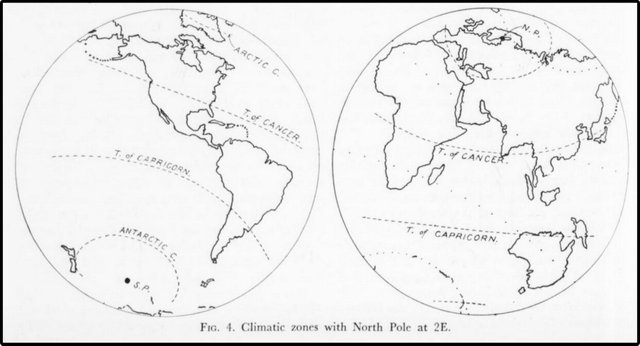
Whatever application Eddington intended his theory to have, Pauly certainly applies it to the Pleistocene Ice Age:
Soon after beginning this study, I became convinced (1) that the unsymmetrical locations of the continental ice sheets with respect to the earth’s poles preclude the assumption that they were caused by shifting of the earth’s axis with respect to the ecliptic, or by a general lowering of the temperature of the earth as a whole; (2) that the ice sheets were not the result of abnormal local conditions, since the time required to produce the great ice caps must have been far longer than it is reasonable to assume that the necessary abnormalities could exist. Also, the contemporary changes in the climates of many widely scattered localities indicated that the cause or causes which brought about the conditions that produced the ice sheets were world-wide in their effects.
Because of these limitations, I felt that all the theories that had been proposed to explain the causes of the Great Ice Ages were inadequate. On the other hand, the Eddington hypothesis seemed free from any of these limitations.
As information concerning the Pleistocene Ice Age is vastly more complete and definite than that of the earlier glacial periods, I chose it for my study. (Pauly 89)
Pauly’s theory envisages successive periods of glaciation in different parts of the world―the glaciation of Europe followed that of North America:
If the lithosphere was displaced during the Great Ice Ages, we should expect ice sheets to develop in the polar areas with the poles at approximately their centers. I shall therefore that the lithosphere was so displaced during Pleistocene time, and that the North Pole lay, successively, approximately under the centers of the Pleistocene ice sheets of the Northern Hemisphere. (Pauly 89)
Pauly theorizes that the North Pole occupied seven different locations: the first two in North America, the third in the North Atlantic, and the last four in Europe. These latter account for the four European glaciations that were then believed to have occurred (known in the Alps as the Würm, Riss, Mindel and Gunz Glaciations).
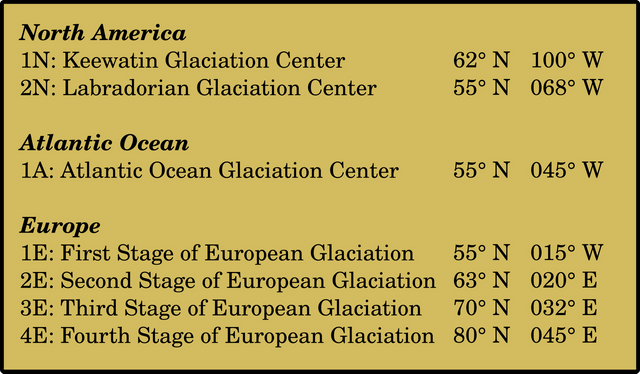
Pauly briefly considers earlier ice ages before drawing a general conclusion, which Velikovsky quotes:
On the basis of these facts, I believe that we are fully justified in concluding that the lithosphere was displaced, as assumed, during the Great Ice Ages, and that the displacements were the direct cause of the alterations in climates during these periods. (Pauly 98 : Velikovsky 115)
Velikovsky, however, does not think that Eddington’s tidal force is sufficient to move the entire crust en masse:
However, in order to move the crust, preserving the axis of the core as that of the entire globe, the friction between the crust and the substratum must be overcome; and because of the equatorial bulge, in order to alter the position of the crust, it must be stretched in some parts. This would require the application of a great force, which does not appear to exist in tidal friction originating in the moon. (Velikovsky 115)
Even if Eddington’s explanation of how the tidal force could move the crust in the north-south direction as well as the east-west direction is accepted, there is still the problem of stretching the crust over the equatorial bulge.
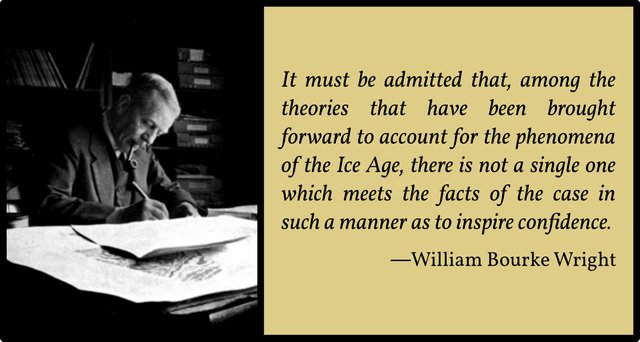
Impasse
We have reached an impasse:
The theory of the sliding lithosphere shares the quantitative inadequacy of the theory of sliding continents. Some motive agent more powerful than tidal friction (Eddington), or gravitational differences at various latitudes (Wegener), or intermittent radioactivity in the earth (Du Toit), must have been at work in order to move continents or the entire lithosphere. Thus these theories meet the fate of the earlier theory that postulated the shifting of the poles because of a geological redistribution of land and sea. (Velikovsky 116)
But the problem of the geographical distribution of the ice cover in the past can only be solved by some such theory. Velikovsky concludes this section by quoting the Irish geologist William Bourke Wright of the Geological Survey of Great Britain and Ireland. The quotation comes from the 1937 edition of The Quaternary Ice Age. This was first published in 1914, but Wright revised it towards the end of his career. It is this second edition of 1937 that Velikovsky cites. This edition is now available to borrow from the Internet Archive.
W. B. Wright, of the Geological Survey of Great Britain, finds that the only way to explain ice ages is to assume that “the earth’s axis of rotation has not always had the same position”; and “since it has now become obvious that geological history has witnessed many changes in the position of the climatic zones on the surface of the earth and that at least one notable glaciation, that of the Permo-Carboniferous [preceding the time of the large reptiles], was due to a displacement of the pole from its present position, it becomes worth while to inquire whether the Quaternary [Recent] glaciation would not have a similar cause.”
But every inquiry in this direction, in Wright’s opinion, failed to find a cause that would account for recurrent but not periodic ice ages; they did not return through geological history at measured intervals. Therefore he concluded: “Among the theories that have been brought forward to account for the phenomena of the Ice Age, there is not a single one which meets the facts of the case in such a manner as to inspire confidence.” (Velikovsky 116-117)

The cause, Velikovsky concludes, must have been sudden, violent, recurrent―but at highly erratic intervals―and of titanic power. What it was will be explored in the following chapter.
And that’s a good place to stop.
References
- George Biddell Airy, On the Computation of the Effect of the Attraction of Mountain-Masses, Philosophical Transactions of the Royal Society of London, Volume 145, Pages 101-, London (1855)
- William Bowie, Isostasy, Beno Gutenberg (editor), Physics of the Earth, Volume 2, The Figure of the Earth, Pages 103-115, The National Research Council, Washington, DC (1939)
- Arthur Eddington, The Borderland of Geology and Astronomy, Nature, Volume 111, Issue 2775, Pages 18-21, London (1923).
- Karl A Pauly, The Cause of the Great Ice Ages, The Scientific Monthly, Volume 75, Issue 2, Pages 89-98, American Association for the Advancement of Science, Lancaster, Pennsylvania (1952)
- John Henry Pratt, On the Attraction of the Himalaya Mountains, and of the Elevated Regions beyond Them, upon the Plumb-line in India, Philosophical Transactions of the Royal Society of London, Volume 145, Pages 53-100, London (1855)
- John Henry Pratt, A Treatise on Attractions, Laplace’s Functions, and the Figure of the Earth, Fourth Edition, Macmillan and Co, London (1871)
- Johannes Herman Frederik Umbgrove, The Pulse of the Earth, Martinus Nijhoff, The Hague, Netherlands (1942)
- Immanuel Velikovsky, Earth in Upheaval, Pocket Books, Simon & Schuster, New York (1955, 1977)
- Felix Andries Vening Meinesz, Spanningen in de aardrost tengevolge van poolverschuivingen, Proceedings of the Royal Netherlands Academy of Sciences, Volume 52, Number 5, Royal Netherlands Academy of Arts and Sciences, Amsterdam (1943)
- Felix Andries Vening Meinesz, Spanningen in de aardkorst door poolverschuivingen, Journal of the Royal Dutch Geographical Society, Volume 60, Number 4, Pages 530-535, Royal Dutch Geographical Society, Amsterdam (1943)
- William Bourke Wright, The Quaternary Ice Age, Macmillan and Co, Limited, London (1914)
- William Bourke Wright: The Quaternary Ice Age, Macmillan and Co, Ltd, London (1937)
Image Credits
- George Everest: Henry Maull & George Henry Polyblank (photographers), Public Domain
- The Great Trigonometrical Survey: © LotusArise (designers), Fair Use
- Pole Shifts and Ice Ages: © Lance Weaver, UtahGeology, Fair Use
- John Henry Pratt: Anonymous Sketch, Cambridge University, Public Domain
- George Biddell Airy: John Collier (artist), Royal Museums Greenwich, London, Public Domain
- Felix Andries Vening Meinesz: Anonymous Photograph, The Royal Society, Public Domain
- Johannes Umbgrove: Anonymous Photograph, Biographical Notes of Members of the Royal Netherlands Academy of Arts and Sciences, Copyright Unknown, Fair Use
- The Vening Meinesz Pole Shift: After Fleshgrinder (designer), Public Domain
- Arthur Eddington: George Grantham Bain Collection, Library of Congress, Prints and Photographs Division, Washington, DC, Public Domain
- Geological Society of London (Burlington House): © Tony Hisgett (photographer), Creative Commons License
- George Darwin: J Russell & Sons (photographers), Smithsonian Digital Libraries, Public Domain
- Fission Theory: T E R Phillips & W H Steavenson, Hutchinson’s Splendour of the Heavens, Volume 1, Page 3, Hutchinson & Co, London (1923), Public Domain
- William Bourke Wright: J K C, Obituary: William Bourke Wright (1876-1939, The Irish Naturalists’ Journal, Volume 7, Number 9, Pages 250-253, Irish Naturalists’ Journal Ltd, Dublin (1940), Public Domain
